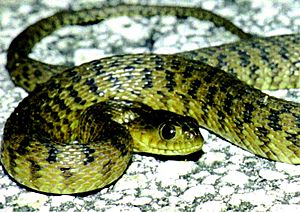Florida green watersnake facts for kids
Quick facts for kids Nerodia floridana |
|
|---|---|
 |
|
| Conservation status | |
| Scientific classification | |
| Genus: |
Nerodia
|
| Species: |
floridana
|
| Synonyms | |
|
|
The Florida Green Watersnake, also known as the Eastern Green Watersnake, is a type of snake found in North America. It's a harmless water snake that belongs to the Colubridae family. These snakes are well-known for living near water.
Contents
About the Florida Green Watersnake
The Florida Green Watersnake is the biggest water snake in North America. When fully grown, it usually measures about 76 to 140 centimeters (30 to 55 inches) long. The longest one ever found was 188 centimeters (74 inches) long!
What Does It Look Like?
Adult snakes are usually solid grey or greenish-brown. Their bellies are white or yellow, but this color gets darker under their tail. A special feature of this snake is a row of scales below its eye. These scales are separate from its upper lip scales. Only the Western Green Watersnake has this same feature among snakes in the southeastern United States.
Young Florida Green Watersnakes look a bit different. They have about 50 dark stripes across their back and sides. These stripes slowly fade away as the snake gets older.
Where Do They Live?
You can find the Florida Green Watersnake mostly in Florida. They also live in parts of southern Georgia and southern South Carolina.
Preferred Homes
These snakes love open, marshy wetland areas. They are rarely found in fast-moving rivers or streams. Instead, they prefer calm waters with lots of plants, like swamps and marshes. You might also spot them in lakes, ponds, and ditches. Sometimes, they can even be found in slightly salty water.
Behavior and Diet
In southern Florida, these snakes are active all year round. However, in colder northern areas, they will hibernate during the winter. On sunny days in colder months, you might see them basking (lying in the sun) to warm up. In southern Florida, they often travel over land when it rains.
What Do They Eat?
Scientists are still learning a lot about what Florida Green Watersnakes eat. Most observations show that they mainly eat fish. This includes fish like sunfish, crappies, and small bass. They also enjoy eating frogs, especially pig frogs, as well as tadpoles and salamanders. Like other water snakes, they swallow their prey whole and alive.
Reproduction and Life Cycle
Like other North American water snakes, the Florida Green Watersnake gives birth to live young. This means the babies hatch inside the mother and are born alive.
Baby Snakes
Mating usually happens in late winter or early spring. Female snakes have very large litters (groups of babies) in the summer. A typical litter can have anywhere from 20 to 40 babies. The young are usually born between June and September. The largest litter ever recorded for this species was an amazing 132 babies from one female!
Predators and Defense
Because Florida Green Watersnakes have so many babies, most young snakes do not survive to become adults. Many animals in their wetland homes hunt them.
Who Hunts Them?
Common predators include river otters, hawks, herons, egrets, ospreys, turtles, kingsnakes, alligators, and different types of predatory fish.
How They Defend Themselves
When a Florida Green Watersnake feels threatened, its first reaction is to try and escape. If it gets caught, it might bite. It can also release a strong, smelly musk from its scent glands to try and get away.
Conservation Status
The Florida Green Watersnake is common in many wetland areas. However, it is less common in the northern parts of its range. Sadly, thousands of these snakes die each year on roads and highways in Florida, especially near wetlands. In the states of Georgia and South Carolina, the Florida Green Watersnake is considered "state imperiled." This means they are at risk in those specific states.


